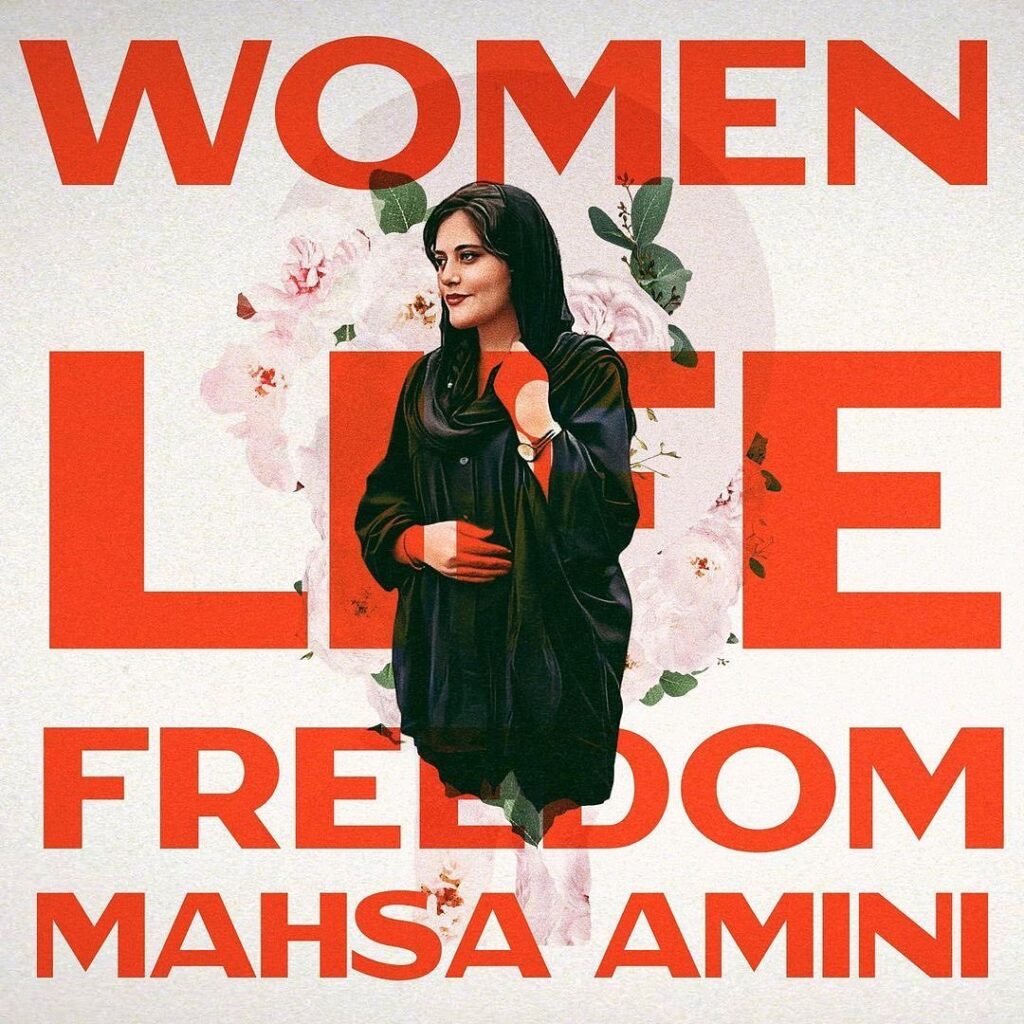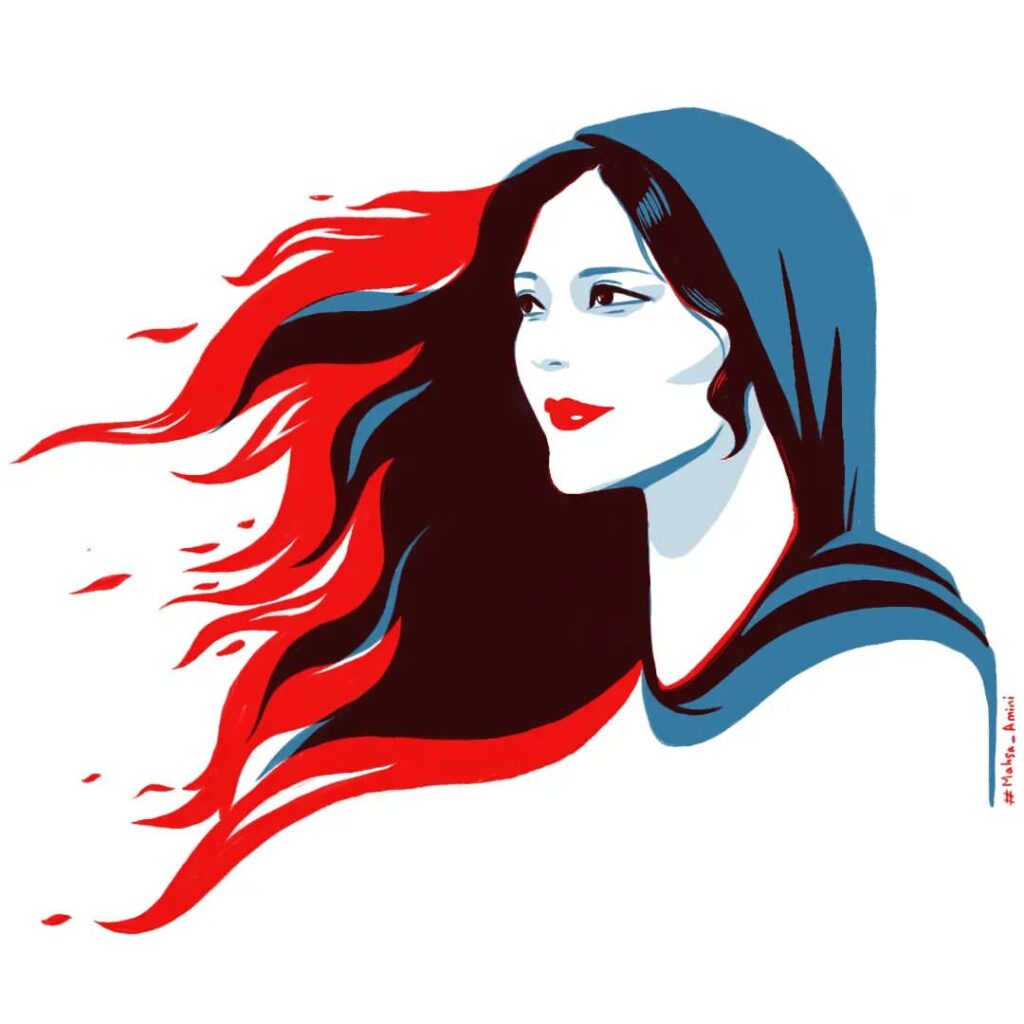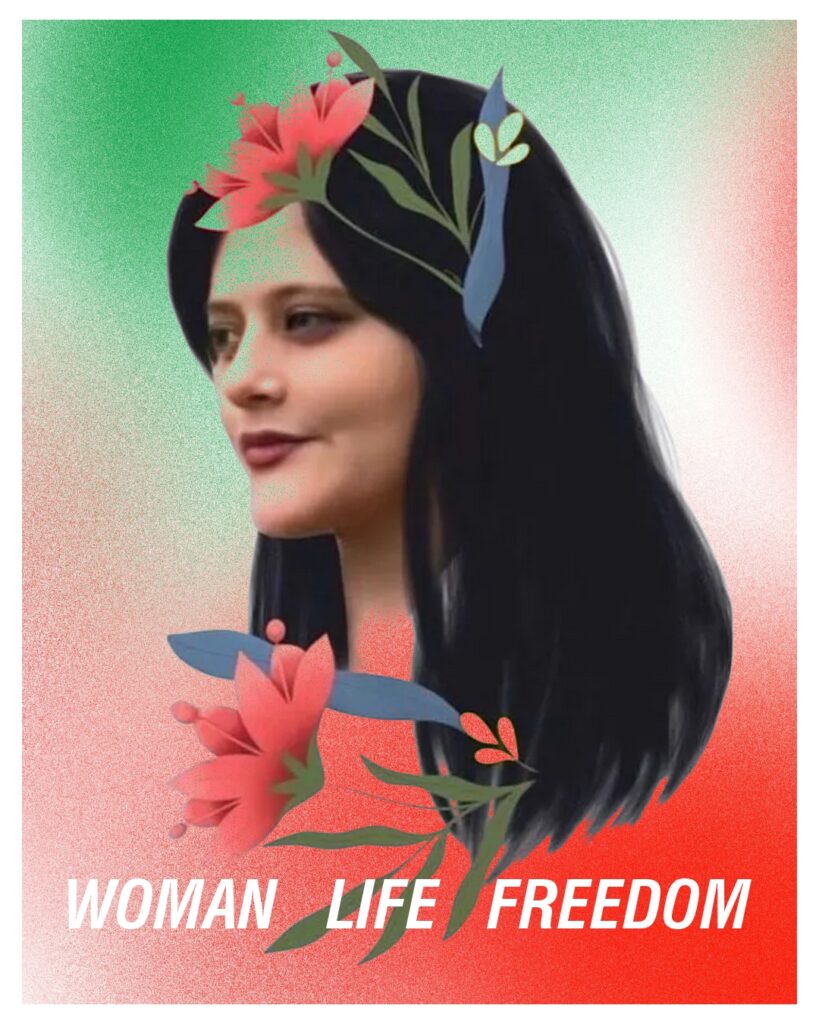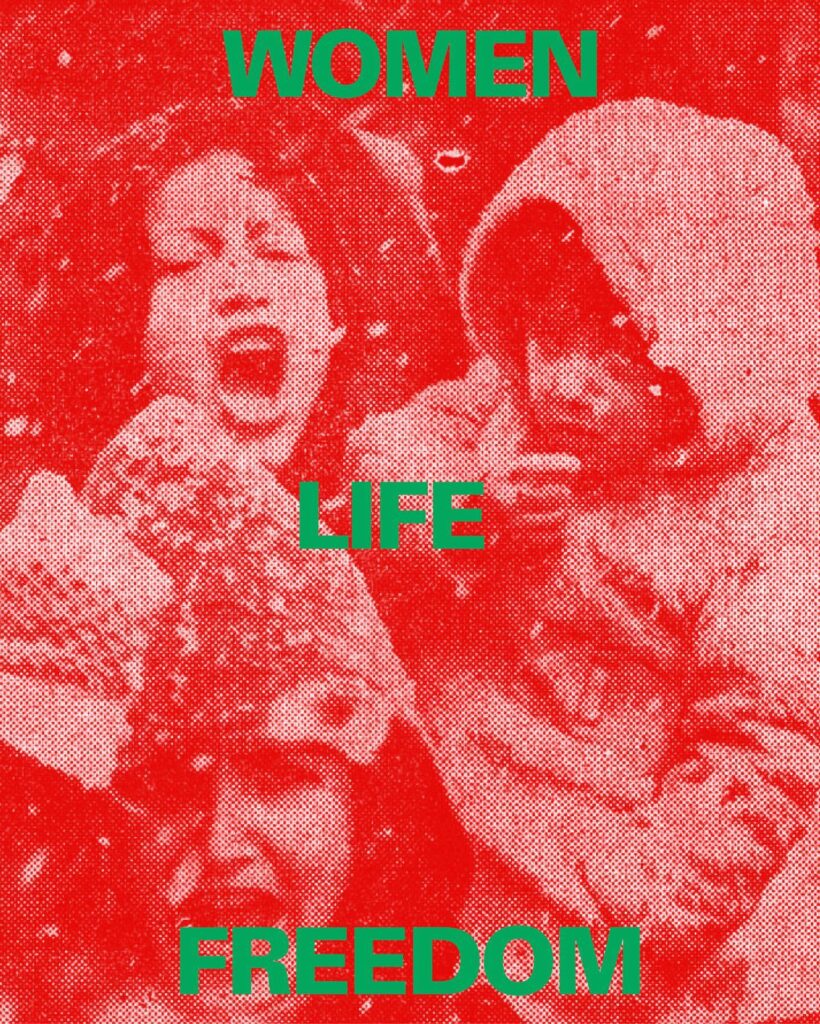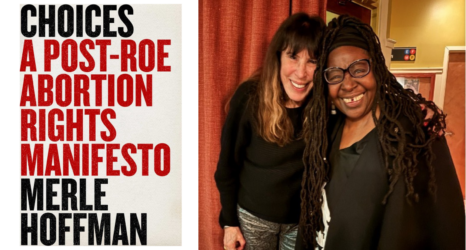“Woman, Life, Freedom” is not three words. It is one breath—a revolt against all death. This is the Rainbow Manifesto.
The Nowruz holidays have ushered in the Iranian New year—the celebration of spring, of fertility and of the earth, celebration of family and friendship, of faces and intentions purified in mirrors of light.
We have entered the year 1402 in the Iranian calendar. And the writing is on the wall. The Islamic Republic’s time is up.
The face of a new Iran is breaking out of Ayatollah Khomeini’s tomb.
The shadow of darkness and cloak of deceit cast over Iran has been rent asunder. The Islamic Republic’s mask has slipped and with it the lie: the crucible of crime and corruption binding the body of the Iranian people to a cycle of death and burial in the name of the Mahdi, the Shi’a messiah.
We are witnessing the Rainbow Revolution, a new day and a new dawn, the first stirrings of an Iranian renaissance, a post-fundamentalist moment and movement whose brilliance and blessings promise to transform the Islamic world, humanity as a whole, even life itself.
There is no missing the global arc or sweeping beauty of this Rainbow Revolution—colored as it is by the dreams and desires, confidence, creativity and courage of a new generation.
The countdown to a free Iran has begun.
Woman, once decapitated, her body mutilated and her limbs scattered as shards and shrapnel burying the earth in the image of man, the faculty of the intellect, has ceased to exist as a corpse: a commodity and currency recycled as property and matter in the mirrors of the state.
The feminine and fertile breathes yet again, as body and spirit, and as vision and vessel for the resurrection, liberation and celebration of life.
The spark for the Rainbow Revolution—the bonfire of veils—enveloping Iran today was the death of Mahsa Zhina Amini, a young Kurdish woman arrested by Iran’s morality police for being improperly veiled. She was severely beaten at a “re-education” center, fell into a coma and died on Sept. 16, 2022. Amini was 22.
That should have been the end of her story—another day, another casualty. Another anonymous woman—a minority at that—murdered without justice, buried without ceremony.
Iran as a landfill, her children trash.
“I can’t breathe”—George Floyd’s last words, now the slogan of the Black Lives Matter movement—had said it all. Ours would be the millennium of extinguished hopes, one where the disposable and faceless masses would wash in and out of the screens of time as corpses without breath, bodies without states, humans without habitats.
With the Great Satan on the run, and the Red Serpent, China and its Taliban on the rise, Iran was bound to go the way of Xinjiang and Afghanistan, the erasure of women and expiration of girls as all but certain, with extinction as the order of time and femicide as the law of nature.
Mahsa’s death was merely a chronicle of another death foretold, yet another footnote in the margins of the book, now, the burka, of time.
No one, least of all our beloved supreme leader, Ayatollah Ali Khamenei could have imagined the birth of the mother of all revolutions: the tipping of his turban, the circumcision of his tongue and the shredding of his image in his very own tent.
And yet—ouch—here it is: an epic feminist revolution in the heartland of Islamic fundamentalism.
There is no missing the global arc or sweeping beauty of this Rainbow Revolution—colored as it is by the dreams and desires, confidence, creativity and courage of a new generation. The countdown to a free Iran has begun.
Millennial moments when a civilization pivots around a unifying vision of life are gifts that infuse history with mystery, the present with purpose and the future with promise.
Sept. 16 is now the cradle of a new calendar—the genesis of a new era in which feminism has fundamentalism, fascism and fanaticism on the run.
In the cosmic clash between heaven and earth, darkness and light, the masculine and the feminine, the mosque and the tavern, thanatos and eros, Iran’s children are tilting the scales of time back towards life. The mantra “woman, life, freedom” envelops the corpse of time and endows the chaos of matter with the majesty of faith in justice. The gravity and sanctity of each word infuses every void, the abyss of space, with music and meaning.
Men, morgues and maps, the barren, hostile and sterile field of geopolitics—a great game of bozkeshi with the corpse of nations torn apart as if the carcass of goats—is impregnated by a new impulse, with “woman, life, freedom” ushering in a vision of the planet unveiled as one breath and body, skin and spirit.
In a state of panic, three misogynist demons—Iran, Saudi Arabia and China—our very own Trumpian clans and clones, have brokered a butchers’ pact: a wall to contain the threat of Mahsa’s army. The new wave of freedom—women, girls and gays—must be stopped … lest the Middle East and Central Asia’s hypermasculine status quo, formerly an American pax, now a Chinese pox, born and bound as it is to speculation in blood, oil and war, comes crashing down on their snake pit—a once fertile, now sterile, crescent in which children, charred, serve as fossils, with the remains of women and their freedom charters as fuel for spurts and spikes in genocidal rates of growth.
But there is no sweeping Mahsa into the oubliette.
Iranian women, the Girls of Revolution Street, are breathing new life into the Beijing Declaration—the revolutionary idea advanced by Chairman Mao in 1949, and no doubt, embraced by Xi Mingze, China’s first daughter, that “women hold up half the sky.”
Mahsa lives through the words now the mantra, “Zan, Zendegi, Azadi” (Woman, Life, Freedom). From Saqqez, her hometown, in Kurdistan to Tehran, Zahedan to Izeh, Tabriz to Isfahan, Qum to Mashhad, her spirit, now a freedom song, radiates through the body and breath of millions in cities and towns across Iran and summons a civilization back to life.
Our lives and the lives of generations before and after us are now inextricably in communion with hers.
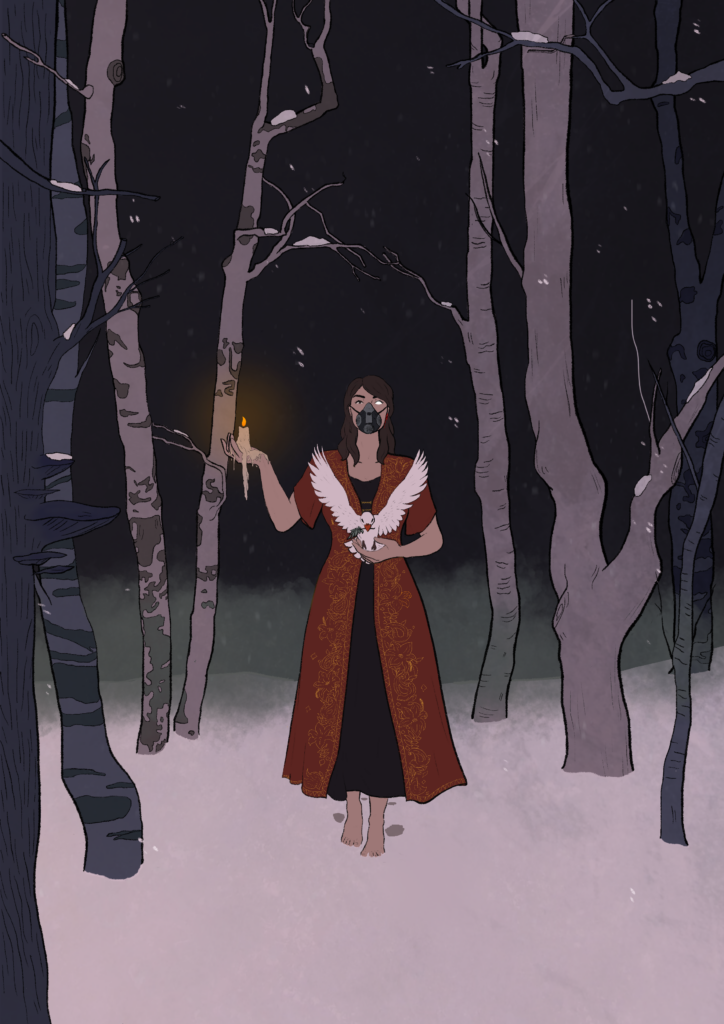
Iran’s global diaspora have heard the cry and joined the fight. Protests, almost around the clock, have spread to over 150 cities around the world from Brussels to Berlin, London to Paris, New York to Los Angeles and Toronto to Vancouver, with synchronicity and symbiosis evidence, if any were needed, that ours is an empire connected by love.
Our protests and processions in the streets and squares of Iran, even the steps of Evin prison, are not an exercise in nostalgia or nihilism. They are the most profound representation and collective affirmation of our commitment to each other’s life and liberty, an act of bearing witness to the birth of a free Iran, to the living and the dead, as solemn and exalted in the graveyards of Saqez, Izeh and Zahedan as any oath uttered or any treaty signed in the great halls of nations.
Our gaze upon history—our very conception of the body politic—has forever shifted.
The tomb of Cyrus is no longer a relic through which a fallen nation looks upon its past with downcast eyes—its spirit of justice asphyxiated in a shroud of dead letters. Cyrus has gone grassroots. His spirit beats and his love pulses through the breath of his daughters—“the Girls of Revolution Street”—more surely than any of the dynasties that have failed or faltered as his facsimiles. His memory animates the ground beneath, the force within and the fire between us.
In truth, we do not need to look to antiquity to grasp the magnitude of this moment. In its 2004 report, “Like the Dead in their Coffin: Torture Detention and the Crushing of Dissent in Iran,” Human Rights Watch had all but written off the Iranian people as dead. Even if one looks at Iranian culture and civilization in terms of decades rather than the millenia, what has come to pass in the name of Mahsa is nothing short of a miracle—an Iranian resurrection.
Let the mullah shut down the internet. Our Iran is not a mirage attached to a socket—our faces a phantasm of electricity, energy or data. Our bodies are not tokens and totems, our spirit a currency encrypted and governed by his criminal codes. Our voices are not signals frozen in the digital wallets and vaults of his cyber army of hi-tech toads.
All his nuclear sorcery and spells—threats, bribes, blackmail and deals—all shades of diplomacy and shadows of death, cannot arrest or delay our dreams by another minute.
We are Iran, wild and unwired, radical and raw, a sovereign matrix of our own making—our batteries charged with love, our bodies powered by life.
Now try unplugging bewilderment—a movement, now story, next myth.
The American hostage crisis ended after 444 days. Today, in the year 1402, after 44 years of captivity, the Iranian people’s hostage crisis is coming to an end.
We are no longer rattling the Islamic Republic’s cage or disturbing the Ayatollah’s peace. We are cracking open the gates of Evin prison.
Breaking out—breathing free.
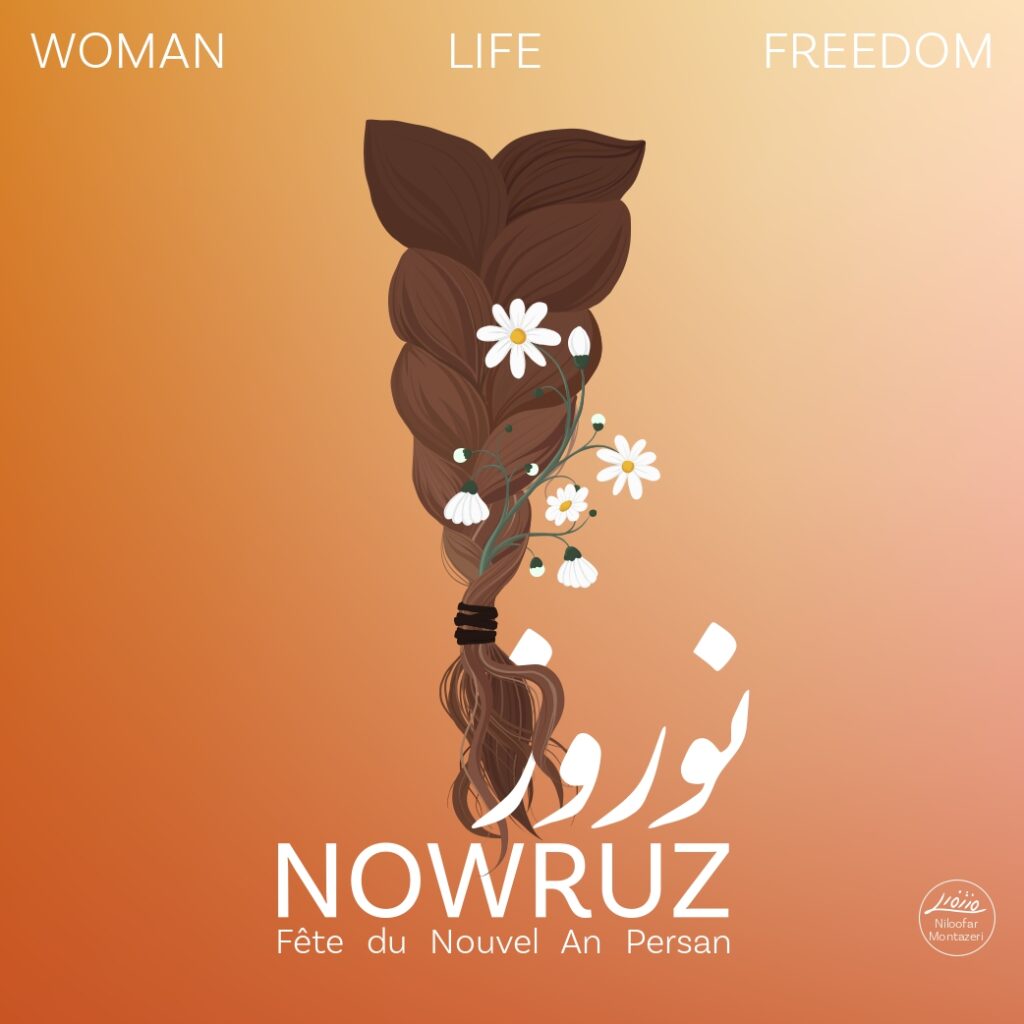
Our Simorgh, a majestic phoenix, with her heart pounding in Iran, his wings spreading beyond, has declared its presence and assumed its station. With our instinct as the way, our mission is as clear as day: to reclaim sovereignty over our name and restore the sanctity of our nest.
We are no longer a nation without a voice or a diaspora without a home. We are a constellation. And Mahsa’s hashtag is our home address—the celestial face of a global Iran.
Mahsa’s name, each and every letter, is the ink that illuminates the hour and the age. Her hair, each and every strand, the string, the instrument and the voice, the flag and the faith of Iran, an uprising, now a resurrection, of the inviolable feminine.
Our prophets and poets, seers and mystics could not have envisaged a more prophetic or poetic moment—the caliphate, a hydra with all its vile and vulgar heads, slain with a wisp of Mahsa’s hair.
With a mere whisper of her name, a veritable conference of the birds, have assembled around their cradle to breathe life back into the miracle that is Iran.
Breathe, they must. And breathe, they have.
The millennia and centuries, the decades and days, even the hours and seconds of expectation are behind us.
Our occultation behind the eclipse of time has come to an end. Our Iran is not a fossil frozen in its past or a fetus locked out of its future.
The waiting game inside a tomb for life in the hereafter is over. Iran is free, past and future entirely present in the mirror of alaan, in the here and now.
Do not seek Mahsa’s reflection behind the mullah’s mirrors of oblivion and obscurity. We no longer appear or disappear in time as shadows without a self, husks without a soul, hearts without a beat.
The mullah’s censorious tongue and teeth, his lewd and lurid gaze—the razor, the lash, the gash and the splash of acid—slashes through our dress and crosses our bodies no more.
The masks of morality and the mark of misogyny, the shrouds covering up the skeletons in our cardinal’s catacombs, the robe of piety itself, burns in the pyre of the sun breathing on our naked skin.
Today, we are harlots and heretics, prostitutes and apostates, faggots and spies, corruption and pollution, excretion and expletives no more.
We have cast off the shrouds of blame that conceal shame to don garments of pride that reveal Iran’s beauty, manifest as shimmering humanity, the alphabet of life.
A bonfire of veils signals an end to our captivity in Khomeini’s puritan hell—the hypocrites in flight, the arsonists on fire, our caliph’s images, sickles and scowls, now shreds, going up in smoke, in a blink.
A kakistocracy croaks, compliments of cackling schoolgirls, their hair, once wound, now wand.
The Ayatollah’s spell is broken, his curse lifted. His ghost gone, the exorcism done.
Our Allah is not his noose. Our Islam is not his lash. Evin is not our Kabaa. Qarchak is not our Qibla.
The Jane Crow era is no more. An abomination in the sight of God and an aberration in the nature of man, the Mullah’s monopoly on the Mahdi’s mint and morgue—trade in women, traffic in children and speculation in corpses—the demon and his dinar,is abolished in a single act.
Qum is in despair, Shiraz rapture.
Read our lips. In our homes and classrooms, universities and seminaries, streets and squares, in the Ayatollah’s embassies, ministries, even in the barracks, we are saying “No to Khomeini.”
“No to Khomeini” means yes—YES—to Iran, yes to woman, yes to life, yes to freedom, and yes to all of creation rejoicing as one.
Mahsa’s story, after all, is not an isolated incident. It is the story of Iran’s rape writ large. Our collective trauma, once masked as coma is now manifest as an awakening, a summoning of spirit and a reclamation of streets through a hail of batons and bullets.
With the earth itself as a veil, a shroud of lies concealing the face of a broken faith, Mahsa resurrects the names of Neda, Sohrab and countless others whose bodies and breath lie extinguished in the name of the Mahdi.
Herein lies the crux of the matter: The fundamentalist contract, the cycle of debt and devotion binding the body of Iran’s children to mutilation in the clocks and martyrdom in the calendars of the Islamic Republic has expired.
Instead of embracing death as carcasses and casualties slaughtered in the morgue, suspended on the crane or crucified in the name of the Mahdi, a new generation is returning the keys of paradise to their elders. What Iran’s children want is a ticket out of Khomeini’s fundamentalist utopia—a decisive break with a theocracy founded on fraud, fear and force.
Instead of boys depositing their corpses in the coffin of the state and girls burying their womb in the tomb of religion, minors are shattering the entire edifice of guardianship—turning time on its head. Our eminences, the greying gargoyles of the graveyard, stand agog and aghast at the prospect of eviction from the morgue—disclosing and disgorging the remains of all the lambs they have deceived and devoured in the name of the Mahdi.
With the Ayatollah targeting the body of Iran’s women and children with the IRGC’s batons and bullets, he has set himself on fire by declaring a war on the Mahdi himself.
Corruption on earth is one thing, the demolition of the heavens quite another.
There is no going back to the old order.
Our Ayatollah has cracked the skull of his theocracy against the bedrock of demography—a generation with a heart, a soul and a conscience. The future has spoken—the rest is history, a question of time.
Without Allah as their butcher’s shop’s brand, a gerontocracy on the decline, now finds itself on a steep incline.
The calendar itself is wheeling our politburo of clerics, by the carton and the council, past all expiration dates. It’s time for an appointment with their own shadow: a plunge—not a mere fall—into a blackhole, with gravity as their guide.
The cosmic pupil dilates and shafts of light pierce this longest and darkest of Persian nights. The shadow of 1,001 scarecrows flickers and dims, with the ultimate veil, the illusion of death, sin itself in flight.
Forough winks.
Hafez, the heretic, flings open the tavern’s door. And reveals all that orthodoxy has forbidden.
A thousand and one Scheherazades, whirl and swirl, dervishes turning, their love, now wind, now fire, now fury, now spirit, blazes against the caliph’s blade, and dances upon time’s sickle. Their each and every breath a rebirth heralds the coming of a new day.
That day is before us.
Listen.
Listen to the sound of a free Iran. With Allah no longer a scythe or a scowl in the sky, schoolgirls giggle—our sparrows, once again free to flutter, chirp and chatter.
And we rejoice, rejoice, rejoice.
Take a peek at their Iran’s many rebirths, a kaleidoscope of freedoms manifest in 1,001 glimpses and posts, in homes and schools, streets and squares, theatres and billboards near you.
My favorites—not to be missed—the new bismillah chorus with hallelujah chimes starring our glitterati, rude little girls with bubblegum, boxing gloves and bicycles, hairy and hair-free, ever so butch and oh so scary.
Behold the miracle.
God’s love gushes through the hearts of our children, the holiest of holy books, our temples and playgrounds of life.
A covenant born out of each of their tears and all of their dreams heals all rifts and binds the heavens back to the earth, compliments of Kian Pirfalak, a murdered child who has endowed Iran with his God of the rainbows.
In Rumi’s mirror of love, all of Iran—the queer and quirky, eclectic and eccentric, wild and funky, the silly and slow, the plain and ordinary—stands redeemed.
The face of his faith holds the reflection of all of Iran’s children—his heart, our constitution; his breath our resurrection.
Welcome to our Iran—the way of love.
Ours is a searing vision of freedom as flight, a journey that begins with the body’s confinement in space and time and culminates in a communion with the sublime, with each moment a miracle and every encounter a revelation and every creature, high and low, yes Satan too, falling within the compass of Allah’s love.
Come friend, come. Let us stand in Mahsa’s light. In Rumi’s truths.
Our global Iran—Rumi’s empire—is a hybrid nation, a synthesis of East and West, born out of 1,001 hyphens, a matrix of families and friendships that connect the world as one. Our culture, rooted in the embrace, exploration and elevation of the other is more vibrant and playful than ever. Born out of immersion in the arts, sciences and technology, it binds knowledge to love and progress to community. It opens the frontiers of invention and pollinates imagination as never before. And it binds intellect to spirit and economics to an ethic that enhances exchange and enriches humanity.
You do not need to look far to find the voice and verse of our Iran. Manifest in the lyrics of 2023 Grammy-winner Shervin Hajipour’s Baraye—“For”—a song, now the anthem of the Rainbow Revolution, its spirit exist, with, through and for the other: “for the stray banned dog” and “for the worn out tree,” “for the Afghan kids” and “for the girl who wishes to be a boy” and “for women, life, freedom.”
What Baraye reveals is the enduring power of an oral tradition and culture, a poetic imagination that echoes with the genius of Saadi, a sculptor whose words bind the moral imagination of the Iranian people, their character, conduct and constitution, to wellsprings of empathy, not enmity. Such compassion and creativity is what breathes life into the fabric of our civilization even in the face of extinction.
None can confine the spirit or extinguish the light of the Rainbow revolution in the frame of constitutions and idols erected in the image of man. The cosmic spark radiating through us cannot be arrested in the morgue of tribe and territory, the corpse of time and ideology, the coffins of state and identity, and the shackles of matter and money. The divine breathes within each and every one of us.
Come friend, come. Let us stand in Mahsa’s light. In Rumi’s truths.
What have we to do with the mullah and his bazaars of death, this game of nuclear arson?
Holding nations as hostages and setting neighbors on fire is not our way. Let the mullah and the merchant wage their games of mutual assured destruction, what have we to do with the shadows cast in the shrine of the apocalypse? Come friend, come, let the mullah and the merchant haggle over the price of death in the corner of this necropolis or that morgue, what have we to do with the foul screeds and filthy deeds that bind men to this underworld?
Come join our movement, stand by our side, sing in our midst, rest, pray and play in the vineyards of our Iran. Drink out of the springs of love and the fountains of light that nourish our soil and soul. Revel in the abundance and joy that flows through our children’s hearts and hands. Wonder in the gardens of a civilization born out of our reverence for water, oases of life and shade summoned out of deserts of salt and sand. There is no end to our gifts, our good faith and boundless fortune, all that we call “Eghbal.”
Under our turquoise dome, in each heart and every home, love, once crushed under the tyranny of the wheel of time is being distilled back into wine, the nectar of life. Our verse expunged of venom, our tongue of malice, we smash Khomeini’s heavenly chalice to raise Khayyam’s earthly cup to the Rainbow Revolution—and the joy of an Iranian renaissance.
Woman, Life, Freedom is not three words. It is one breath—a revolt against all death.
Up next:
U.S. democracy is at a dangerous inflection point—from the demise of abortion rights, to a lack of pay equity and parental leave, to skyrocketing maternal mortality, and attacks on trans health. Left unchecked, these crises will lead to wider gaps in political participation and representation. For 50 years, Ms. has been forging feminist journalism—reporting, rebelling and truth-telling from the front-lines, championing the Equal Rights Amendment, and centering the stories of those most impacted. With all that’s at stake for equality, we are redoubling our commitment for the next 50 years. In turn, we need your help, Support Ms. today with a donation—any amount that is meaningful to you. For as little as $5 each month, you’ll receive the print magazine along with our e-newsletters, action alerts, and invitations to Ms. Studios events and podcasts. We are grateful for your loyalty and ferocity.



